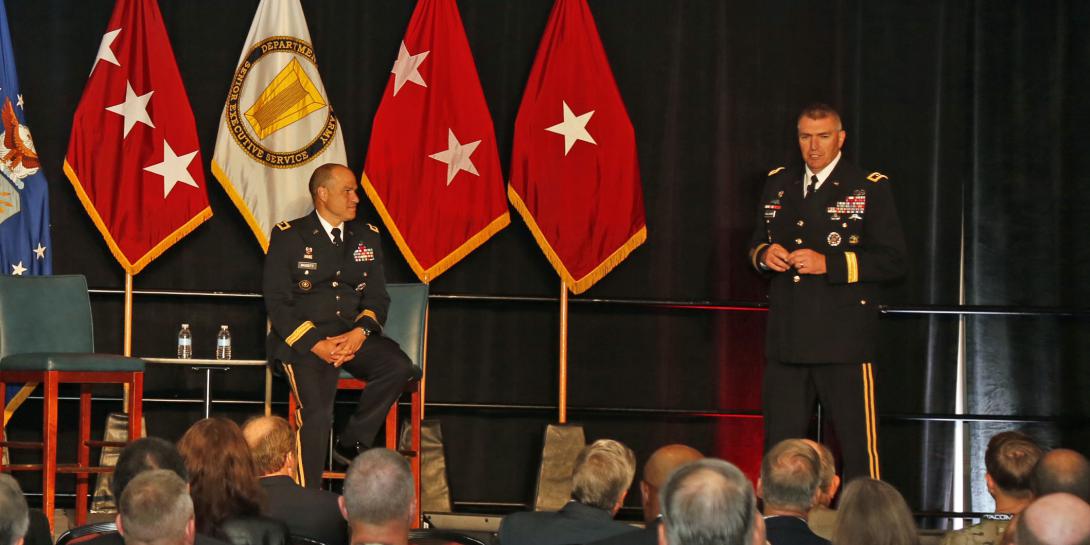Army Delivering on Its Network Promises
The U.S. Army already is delivering several components of an integrated tactical network (ITN), a concept designed to allow the service to keep pace with technological advances, insert new capabilities as they become available and address emerging threats.
The ITN focuses on a simplified, independent, mobile network solution that does not rely on a single component to provide enhanced network availability down to the small unit dismounted leader. It takes advantage of both commercial and military network transport to enable communications in disrupted, disconnected, intermittent and limited bandwidth environments, according to an Army article.
Through a series of experiments and demonstration exercises, the service already is delivering some capabilities to several units, according to Maj. Gen. Peter Gallagher, USA, who leads the Army’s cross-functional team for network modernization, and Maj. Gen. David Bassett, USA, program executive officer for command, control and communications–tactical. The two generals made the comments during a tag-team presentation at the AFCEA TechNet Augusta conference, Augusta, Georgia.
“We’re on the precipice of an unprecedented capability in the ITN,” Gen. Bassett declared. “We really are in an exciting time for the network with the programs we are going to deliver over the next 12 months.”
The generals included two software-defined radio systems: the Manpack Radio, which is undergoing low-rate production with Harris Corporation and Rockwell Collins, and a two-channel leader radio program, potentially valued at $4 billion. A contract for the two-channel leader radio could be awarded “in a very short period of time,” Gen. Bassett suggested.
Both software-defined radio systems communicate with existing waveforms while allowing the Army to insert new capabilities as they become available. “We know we’re going to be making some network design choices about what waveforms we want to have on those radios to give you the best, most flexible capability out there in a contested environment,” Gen. Bassett stated.
They also cited mission command software for both the command post and for the mounted computing environment. The Army is developing two versions of the latter, one aligned with trends in soldier systems, the other compatible with the command post, the program executive officer reported.
Over the past year, the Army also has taken advantage of off-the-shelf systems being acquired by joint forces and special operations forces to provide some Army units with capabilities they’ve never had before, including new radios, advanced waveforms and satellite terminals. The new units also operate under less stringent security classifications and with NSA-approved commercial encryption so they can more easily share information with allies and partner nations.
“Right now, that’s one of the things we’re focusing on—adapting and buying solutions off the shelf that are being used by our joint and special ops teammates to improve the network. It’s really about improving our joint warfighting capability,” Gen. Gallagher reported.
Such off-the-shelf systems allowed the service to rapidly equip the recently-created Security Force Assistance Brigades (SFABs) with ITN capabilities, Gen. Gallagher said. “We were able to get some kits into the hands of some soldiers and get some feedback. These new brigades stood up … not using legacy program radios but actually giving them the kit the special ps community is using.”
The new units were being manned, trained and equipped all simultaneously. “We were rushing to get a capability we had never fielded before into the hands of brand new brigades,” Gen. Gallagher explained. “It wasn’t perfect. We were running hard. We were getting it out the door, and we did it as quickly as we could. The ITN was employed in various European countries, including Poland, during a NATO exercise Saber Strike 2018. The units with the ITN components included the 2nd Cavalry Regiment, 82nd Airborne, and 173rd Brigade Combat Team. The units integrated well with joint and international forces.
The Army is codifying a process of agile and iterative experimentation and performance testing along with soldier feedback to identify technologies to be a part of the ITN. It remains to be seen whether the systems fielded today will be part of the network tomorrow. “This is a subset of the network we need for the long term. This is fixing our ability to fight tonight because the systems are out there,” Gen. Gallagher said, adding that defining the future requirement is key.
The service is undergoing a “horizontal integration workshop” this week to determine “the underpinnings of this network design,” Gen. Gallagher added.
Gen. Bassett stressed that the evolving ITN must be affordable. “We don’t want to field one exquisite network to one single brigade and then not be able to afford it anywhere else,” he said.
Indeed, part of the Army’s modernization challenge is deciding where to allocate funding. Army leaders are debating budget systems out to 2024. “Over the last three weeks, four weeks, we’ve been really laser focused on alignment of resources,” Gen. Gallagher added. If the service does not get the resource alignment right, he warned, its modernization plans will be a “pipe dream.”





Comments